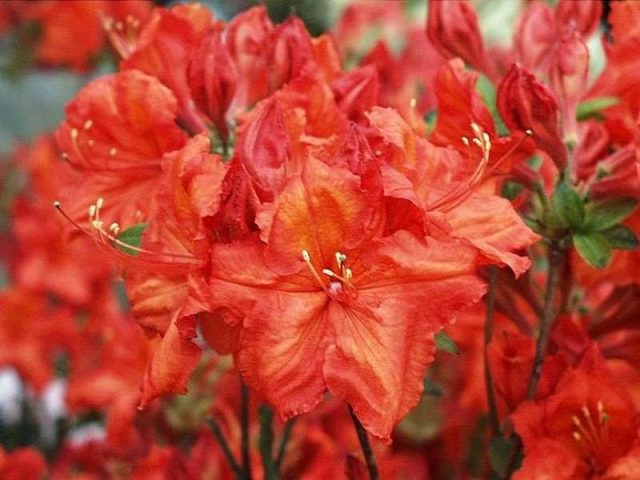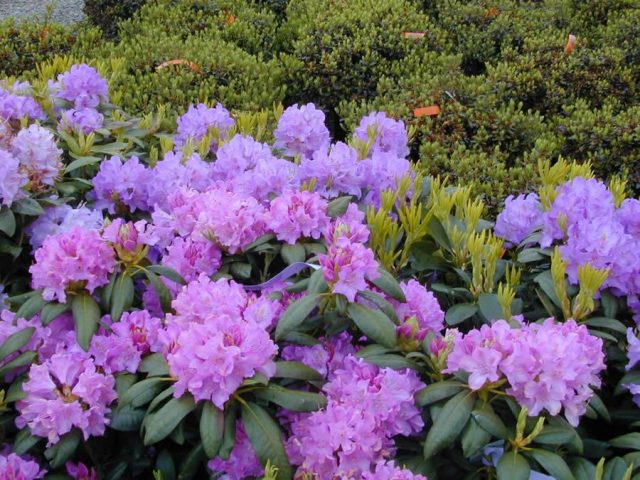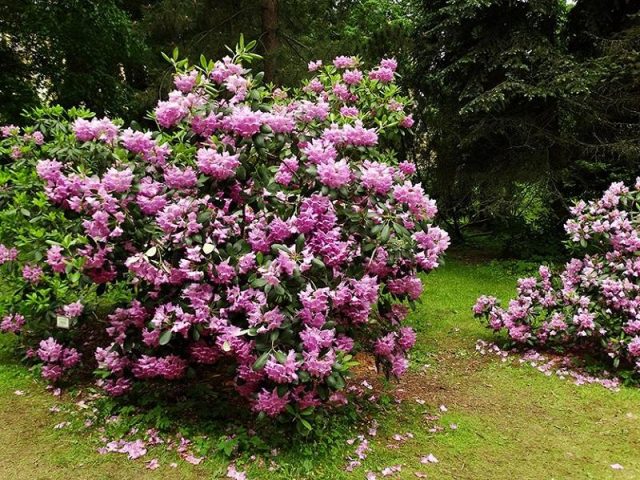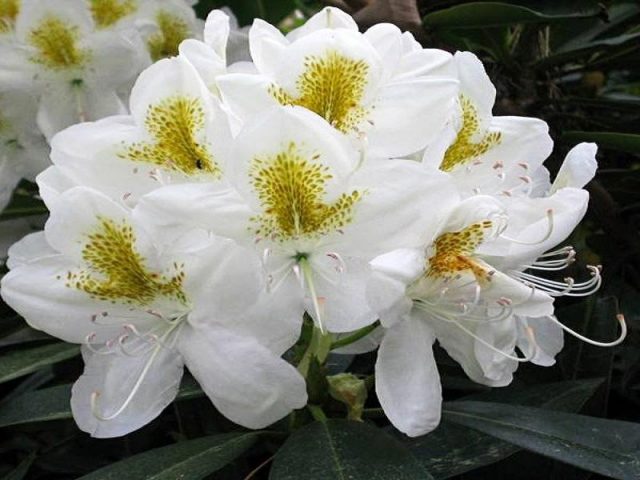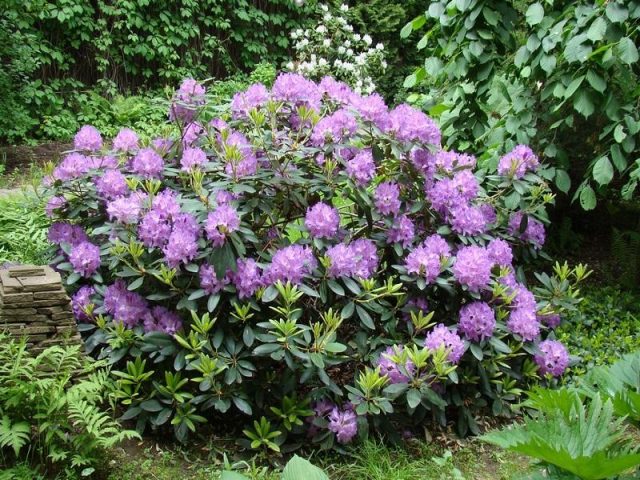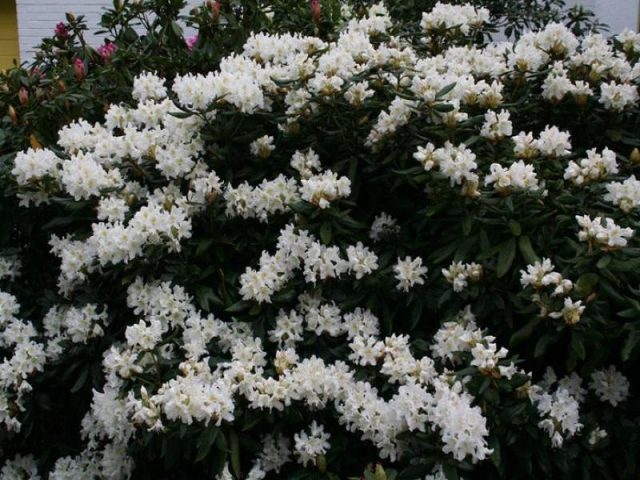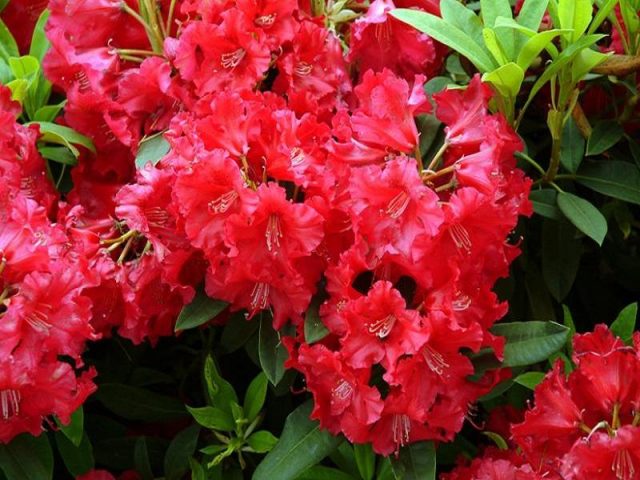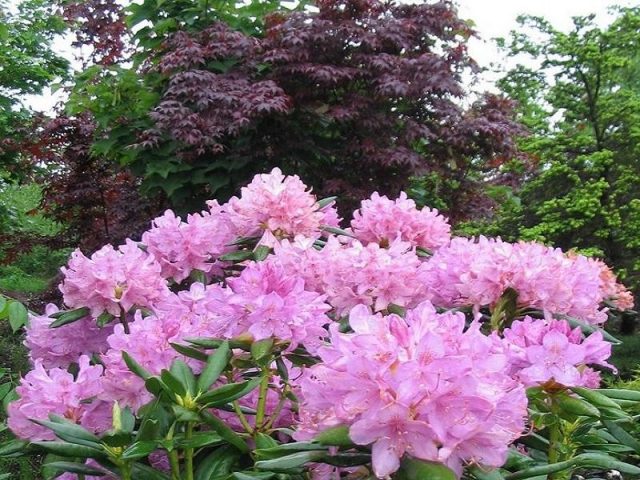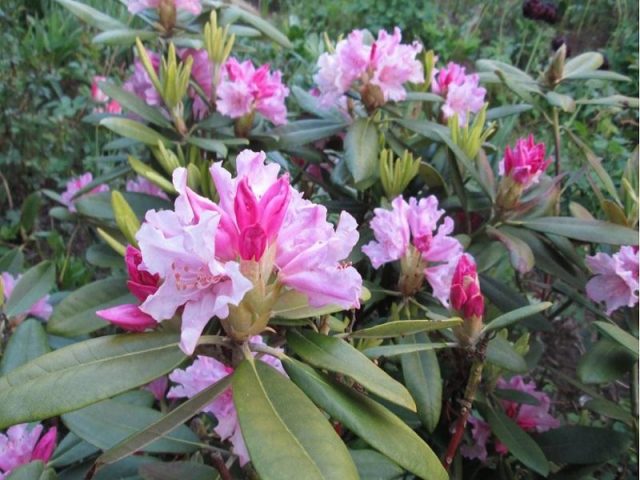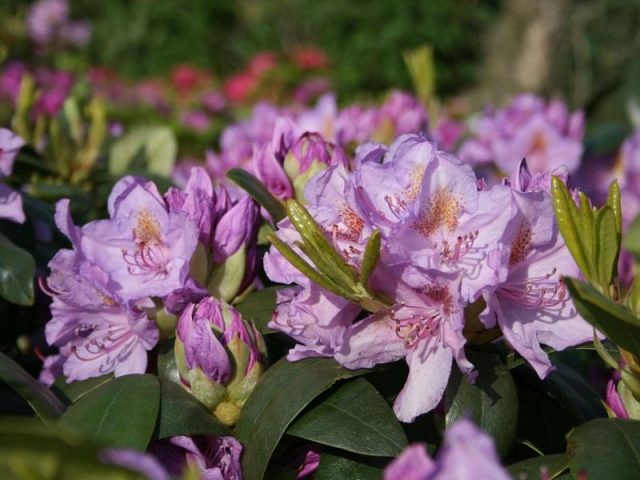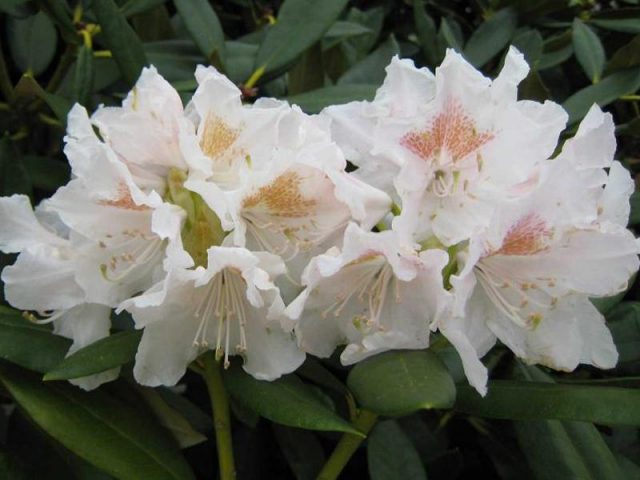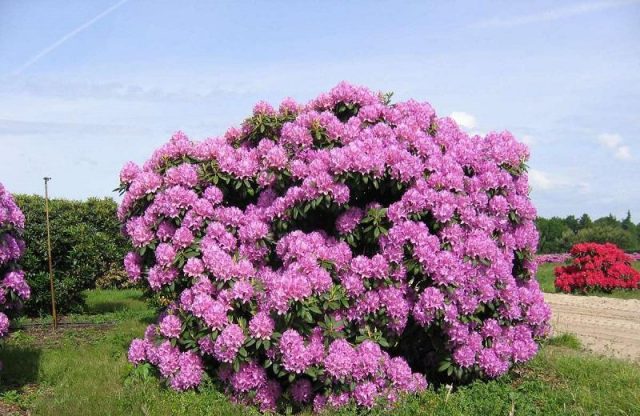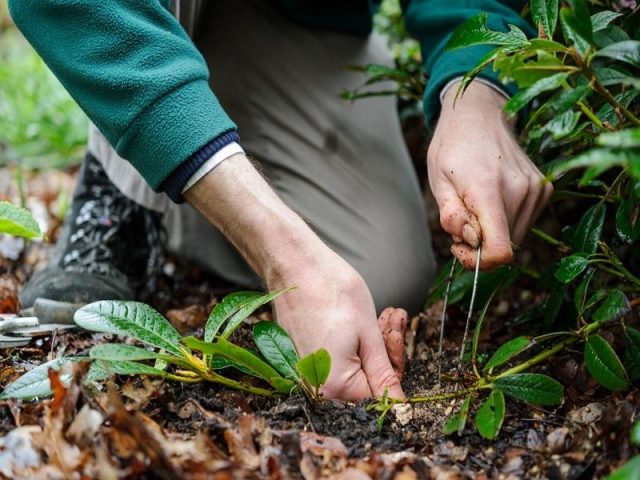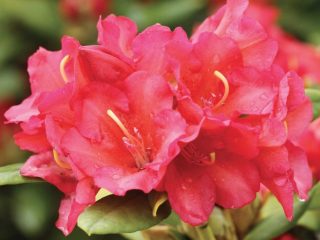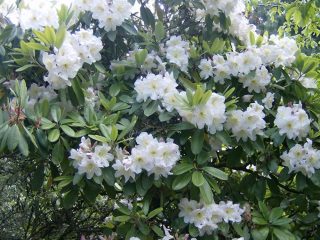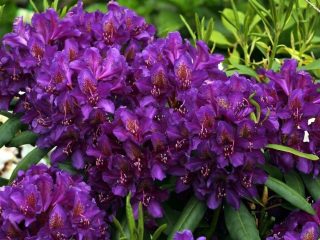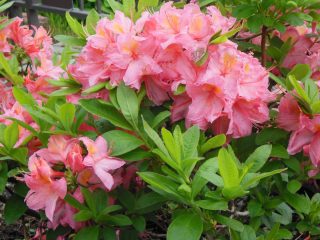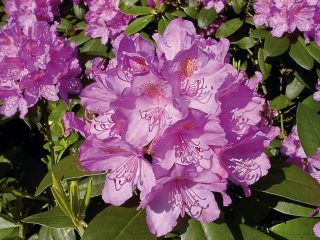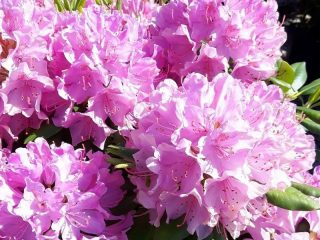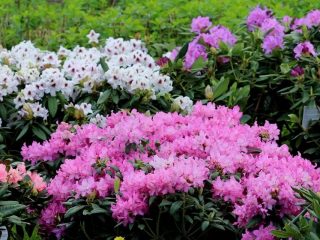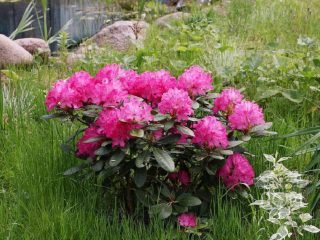Content
Katevbinsky rhododendron, or multi-flowered azalea, is not only a beautiful, but also a very persistent plant. It is not afraid of frost, air and environmental pollution. It can decorate garden plots for 100 years of its life. It will not be difficult for a gardener to choose a variety to suit his taste and grow a magnificent plant. To do this, you should become familiar with the basic principles of planting and caring for large-flowered azaleas.
Description of Rhododendron Katevbinsky
Evergreen Katevbinsky rhododendron (rhododendron catawbiense) is a shrub used as a garden plant and the basis for breeding work to create winter-hardy varieties. Its genes are present in many frost-resistant species.
The height of the bush is up to 4 m, the diameter is slightly larger. At the age of 10 years it reaches 1.5 m in height.At the same time, the annual growth is 10 cm.
Young shoots of Katevbinsky rhododendron have felt pubescence and later become bare.
The leaves of the plant are elliptical, smooth, with blunt ends, up to 15 cm long and 5 cm wide, with 16 pairs of veins. Their color is dark green, with shine. Petioles - 3 cm.
Twenty large bell-shaped flowers of lilac, purple, violet-red shades are connected in inflorescences. Their pedicels are 3 cm long and covered with hairs. The corolla has a diameter of 6 cm and has rounded lobes. The flower has 10 stamens, the style is bare. Flowering lasts about a month. Katevbinsky rhododendron has no aroma.
Winter hardiness of Katevbinsky rhododendron
Frost resistance allows you to endure winter stress in the form of precipitation, wind, frost, icing, and short-term thaw. Maximum frost resistance refers to the extremely low values that plants can successfully survive.
Katevbinsky rhododendron grown in the Moscow region has the properties and advantages of winter-hardy varieties:
- very high frost resistance;
- compactness of the bush;
- the branches are rigid and not susceptible to injury under the weight of snow;
- hardening, which allows flower buds to survive the winter.
Katevbinsky rhododendron came to Europe from North America; its qualities are used to develop new varieties.
Varieties of rhododendron Katevbinsky
In order to choose a specific variety, you can get acquainted with the Katevbinsky rhododendron and its varieties from the photo or visit a flower exhibition.First, you need to decide on the requirements for azaleas: the size of the future plant, its characteristics.
You can choose a variety to suit every taste.
- If you need a deciduous shrub, then you can opt for Katevbinsky rhododendron (azaleas) Feuerwerk. It is decorative not only with scarlet flowers, but also with orange leaves in the fall. The plant will decorate the garden in September no less than in summer;
- The large lilac inflorescences will delight gardeners with the Katevbinsky rhododendron Boursault - an evergreen shrub with impressive dimensions: up to 2 m in height and 2.5 m in diameter;
The most popular and beautiful varieties are:
- Roseum Elegance;
- Album;
- Bourso;
- Cunninghams White;
- Grandiflorum;
- Nova Zembla.
Rhododendron Katevbinsky Roseum Elegance
The hybrid was obtained in England in the middle of the 19th century. This is an evergreen shrub, reaching a height of 3 m. Every year its shoots increase by 15 cm. The crown of the bushes is thick and dense. The leaves are leathery, shiny, dark green.
Purple inflorescences with copper speckles of 15 buds bloom in June. Flowering continues for two weeks, which, with proper care, can repeat in the fall.
As you can see in the photo, Katevbinsky rhododendron Roseum Elegans looks great in single plantings, on lawns, under the canopy of coniferous and deciduous plants. Group arrangement is no less impressive. Even a separate bush in any corner of the garden looks stylish and elegant.
Rhododendron Katevbinsky Album
The description of Rhododendron Katevbinsky Album indicates that it is an evergreen, spectacular shrub that has a spherical crown shape, slightly raised and dense. In adulthood, the plant reaches a height of 3 m. Its annual growth is 15 cm.The leaves of the plant are leathery, dark green, long.
Album flowers are extremely beautiful. Their buds are pink, and after blooming they are white with a golden mark. Flowering occurs early, already in mid-May.
The frost resistance of the crop is good. Foliage needs protection from sunburn in winter. The plant loves light, but does not tolerate shadow well. It is resistant to pests and diseases.
Rhododendron Katevbinsky Album is used for landscaping areas, parks, and gardens in combination with other ornamental trees and shrubs. The plant looks especially advantageous against the background of coniferous plants.
Rhododendron Katevbinsky Burso
This is a fairly old variety, born in 1849. It is considered one of the hardiest.
The hybrid rhododendron Katevbinsky Burso has dark green shiny elliptical leaves, the length of which is 14 cm, width - 5 cm. The abundant flowering of the species begins in June and lasts three weeks. Large lilac flowers are collected in 20 inflorescences, later turning pink and even white. The plant's shrub is tall, up to 4 m, produces large annual growth, loves acidic, well-drained soil, and does not tolerate waterlogging.
In open spaces, shrubs require shelter from the winds and spring sun. Wilted inflorescences should be removed to allow flower buds to form next year.
Rhododendron Katevbinsky Burso is very decorative during flowering and after it, which is used by flower growers when decorating lawns, lawns, estates, and gardens.
Rhododendron Katevbinskiy Cunninghams White
In Scotland, in the middle of the 19th century, a very elegant variety was bred - Cunninghams White. The Katevbinsky rhododendron bush is small, its height is 2 m, the crown diameter is 1.5 m.The leaves of the bush are leathery, dark green, light underneath. The inflorescences are large, white, with brownish specks on the petals. Flowering lasts about 3 weeks. It is recommended to choose a place for the plant that is quiet, protected from drafts, and shaded. Rhododendron Katevbinsky requires increased moisture in dry years. He loves rich soils, but is also tolerant of poor, alkaline soils. The plant has high winter hardiness provided the bush is covered and the soil is mulched.
Experts recommend the use of Cunninghams White for hedges that are not trimmed. It is possible to plant the crop singly and in groups, in combination and in compositions with other ornamental plants in rose gardens, on terraces, and lawns.
Rhododendron katevbinskiy Grandiflorum
This is one of the oldest varieties, obtained from selected seedlings of wild Katevbinsky rhododendron. The evergreen Grandiflorum has a spreading, ball-shaped crown and elliptical, leathery, bright green leaves. The shrub is frost-resistant and grows quickly. Its flowering begins in June. The purple inflorescences with a greenish-yellow spot are large, odorless, and contain up to 15 flowers.
Like all heathers, Katevbinsky rhododendron prefers well-drained soil and is tolerant of dimly lit areas.
Planting and caring for Katevbinsky rhododendron
Katevba rhododendron is one of the most winter-hardy crops. His kidneys can withstand temperatures down to -25 oS. It is not afraid of thaws and frozen soil in winters with little snow. It is more difficult for a plant to withstand the scorching rays of the sun in winter and spring.The optimal temperature range is from -15 to +25 oC. In the middle zone, it is worth mulching the soil near the Katevbinsky rhododendron and covering it with agrofibre to protect the foliage from burns.
Soil requirements are not high. The main thing is that they are not calcareous, very sandy or exclusively clayey. Plants will die if their roots are constantly in water. The best composition for the soil mixture is forest litter, peat and sand.
Planting is carried out in spring in cloudy weather. The soil should be moist. The earth ball is soaked in water for several minutes. The planting hole is made wide, but not deep.
Selection and preparation of a landing site
The choice of location for Katevba rhododendron depends on whether it is deciduous or evergreen. The former require a lot of light, they can grow in the shade, but will bloom poorly. The latter love shading. All Katevba varieties do not tolerate drafts or drying winds. An area near a fence or tall trees is quite suitable for planting them. You must not allow snow to fall on the bushes from the roof of the house. Since Katevba rhododendron has superficial roots, its neighbors should not be birch, linden, willow, maple - plants with the same structure of the root system. The roots of oak, larch, pine, apple and pear trees grow deep. They can peacefully coexist without interfering with each other.
Seedling preparation
Katevbinsky rhododendrons tolerate transplantation and change of location better at the age of 3 years. It is worth purchasing them from a trusted nursery, where there is a guarantee of purchasing a healthy, varietal seedling. It needs to be inspected. The leaves and stems of the plant must be healthy, without spots, swelling, or damage. It’s good when the bush begins to branch near the neck.
Before planting the plant, it is recommended to thoroughly wet the earthen ball and carefully remove it from the container. Sometimes a felt layer of dead roots is found on the coma. It is carefully removed, the seedling is lowered into water and kept in it until the bubbles stop coming out. When the roots and earthen ball are saturated with moisture, you can begin planting.
Landing rules
To plant Katevbinsky rhododendron, several rules must be followed:
- since the roots of the plant are superficial and spread horizontally, therefore the width of the planting hole should be twice its depth (30 cm and 60 cm);
- the pit is made much larger than the earthen ball of the seedling;
- a drainage layer of broken brick, pebbles or crushed stone is required;
- the soil mixture is poured onto the drainage in a layer of 10 cm and watered abundantly;
- install the seedling vertically, its root collar should be 5 cm above the ground;
- after the soil settles and the neck drops to the ground level, the substrate should be added and watered generously;
- then pour a layer of mulch from peat, pine needles or oak leaves;
- For several days, the Katevbinsky rhododendron should be shaded using fabric, mesh, or a paper cap.
Watering and fertilizing
Watering of Katevbinsky rhododendron is carried out moderately, with rain or settled warm water. Moisture must penetrate to a depth of at least 30 cm. Faded and matte foliage signals the need for watering. Periodic morning spraying of plants should be carried out to maintain the required air humidity (about 65%). The watering norm for adult Katevba rhododendrons is about 10 liters of water for 1 bush three times a week.For young plants, the rate is reduced by half.
Additional watering is necessary in preparation for winter. At this time, the plant is moistened abundantly and the layer of mulch around the bush is increased.
Feeding should be done several times a season. When planting, microelements are added to the soil. Nitrogen is added in early spring and before flowering ends. In the fall, fertilizing is carried out with phosphorus and potassium fertilizers.
Trimming
Only if necessary, the Katevbinsky rhododendron bush is pruned. The procedure is carried out no more than once every 3 years. The reason may be the need to renew the bush or freezing of the shoots.
Most often, pruning for the purpose of shaping is not required, since the Katevbinsky rhododendron has a regular and beautiful natural shape.
If shortening or cutting branches is necessary, you should know a few nuances:
- the procedure is carried out until the kidneys swell;
- the cut is made directly above the dormant bud and treated with garden varnish;
- some time after pruning, the plant will begin active growing season, during which Katevba rhododendron is regularly watered and fed.
In order to rejuvenate the bush or cut out branches damaged after wintering, they are shortened at a height of 30 cm from the soil level. To facilitate the restoration of the bush, pruning is carried out for 2 years - half annually.
In order for the deciduous Katevba rhododendron to be thick and voluminous, it is necessary to pinch out young shoots in June, remove faded buds after flowering, and cut out all weakened branches in September.
Preparing for winter
To prepare for the winter period, fertilizing with nitrogen is stopped in August and they switch to potash fertilizers, which allow young shoots to ripen.
Katevba rhododendrons should be treated with fungicides to prevent fungal diseases.
Winter shelter depends on whether the rhododendron is evergreen or deciduous.
For deciduous species, it will be enough to additionally mulch the soil with pine needles, leaves, and peat. A young plant (up to 3 years old) should be fully covered like evergreen varieties:
- Create a frame from boxes, planks, sticks.
- Cover the root system with mulch from pine needles and peat.
- Cover with non-woven material in several layers over the frame.
- Leave some air space between the shelter and the branches.
- Complete cover should be carried out after the onset of frost, in November-December.
- The top of the plants is covered with film after the final onset of winter frosts, leaving room for ventilation.
Reproduction
Katevbinsky rhododendron can be propagated in several ways:
- cuttings;
- layering;
- seeds.
For the first method, cuttings 8 cm long are cut from adult plants, placed in a solution of a growth stimulator for 12 hours and planted in a mixture of sand and peat, covered with polyethylene. Ventilation and watering must be carried out periodically. After 4 months, the cuttings are rooted and then transplanted into a substrate consisting of peat and pine needles.
Reproduction of Katevba rhododendrons by layering consists of digging in a young shoot, without separating it from the mother plant. After rooting, the seedling is placed in a permanent place.
The third method involves sowing seeds into peat to a depth of 1 cm. After several leaves appear, the seedlings are planted in separate containers.They are assigned to a permanent position only in the second year.
Diseases and pests
Despite the resistance of Katevba rhododendron to diseases, under unfavorable climatic conditions and violations of plant care rules, pathologies can develop:
- tracheomycosis wilt - the roots become brown and rot;
- late blight rot - provokes the covering of stems and roots with crimson spots, their rotting, after which the plant withers;
- bacterial cancer - when growths form on the roots, the plant dies;
- bud rot - the buds of the Katevbinsky rhododendron turn brown, and later wither and dry out;
- wax disease - deformation and thickening of leaves.
Among the pests of rhododendron Katevbinsky, the most common are:
- sulcata weevil;
- spider mite;
- tobacco thrips;
- rhododendron bug;
- whitefly;
- snails and slugs.
Conclusion
Katevbinsky rhododendron is one of the most beautiful shrubs. The splendor of lush inflorescences ennobles any area, making it cozy, elegant and unique. Frost resistance and unpretentiousness are conditions for the possible cultivation of plants in many regions of the country.
